Submachine guns companies VBR Belgium
Of particular interest are projects that are not limited to only one solution, around which the designers work. A more flexible approach to the development of weapons, during which not only a separate unit can be changed, but the entire structure is completely redesigned, is interesting, first of all, by the ability to follow how views on the very concept of personal defense weapons changed within the walls of one weapon company . There are few examples when designers do not only rest on one idea, trying to bring it to acceptable characteristics, but are willing to sacrifice the time and resources already spent for the sake of a more promising design, but they exist. In this article we will try to get acquainted with the weapon that was developed by the designers of the Belgian company VBR Belgium. Unfortunately, there is little information about these weapons, but even that which is is, at least, of interest.
Submachine guns from VBR Belgium MC-PDW and PDW
If you look at the chronology of the development of these two submachine guns, it becomes clear that the first PP was created with a longer name. Many sources indicate that these weapons were designed to test new 7,92x24 ammunition, also developed by VBR Belgium.
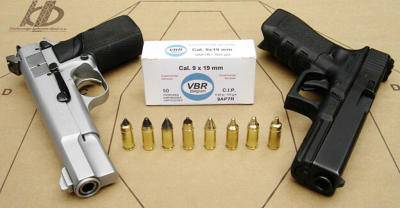 In principle, such an assertion is quite logical, since it is the ammunition that determines the future characteristics of the weapon, and creating a new product for already known and widespread cartridges, there is a 100% chance of making just another analogue of what is on the market. In addition to the 7,92x24 ammunition in the new weapon, the possibility of interchangeability with the 9x19 was apparently tested, as can be seen from the image of the submachine gun along with the above-mentioned cartridges. And since we are talking about ammunition, we will try to deal with them in more detail, as far as available information allows.
In principle, such an assertion is quite logical, since it is the ammunition that determines the future characteristics of the weapon, and creating a new product for already known and widespread cartridges, there is a 100% chance of making just another analogue of what is on the market. In addition to the 7,92x24 ammunition in the new weapon, the possibility of interchangeability with the 9x19 was apparently tested, as can be seen from the image of the submachine gun along with the above-mentioned cartridges. And since we are talking about ammunition, we will try to deal with them in more detail, as far as available information allows.As you know, with the spread of body armor, gunsmiths faced the problem of creating a cartridge for pistols and machine guns, whose bullet would not only have armor-piercing properties, but would also have a good stopping effect, instantly transferring the remaining kinetic energy after the armor was broken through, to the body of the enemy. It is necessary to say at once that such a requirement in the framework of creating cheap and mass ammunition is practically impossible, therefore, in most cases, we have two extremes, either good armor penetration or good stopping power.
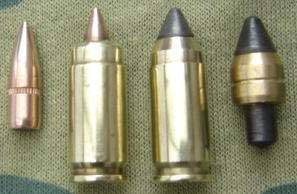 The designers of the company VBR Belgium, sensibly weighing all the pros and cons, decided to make a “relief” in the requirements for new ammunition. So, from the new cartridge required a good penetration of personal armor without any special requirements to defeat the enemy after the passage of the armored plate, but if the enemy is not protected by body armor, the ammunition had to work out its effectiveness when hit as much as possible.
The designers of the company VBR Belgium, sensibly weighing all the pros and cons, decided to make a “relief” in the requirements for new ammunition. So, from the new cartridge required a good penetration of personal armor without any special requirements to defeat the enemy after the passage of the armored plate, but if the enemy is not protected by body armor, the ammunition had to work out its effectiveness when hit as much as possible.Initially, work on a new ammunition was limited only to the cartridge 9х19. Given the wide distribution of this cartridge, it was quite logical to try to squeeze the maximum out of it, since new ammunition, even with very good characteristics, most often do not find wide application. In the process of working on a new cartridge, first of all, the attention of designers was drawn to the design of the bullet. It was possible to find three variants of this ammunition, but perhaps there were others. In one embodiment, an armor-piercing arrow-shaped core with a diameter of 9 millimeter was placed in a bullet with a caliber 6,3 mm. The other version of the cartridge was more original. In it, the role of the armor-piercing core was performed by the bullet of the cartridge 5,56х45, which was placed in the bullet from the cartridge 9х19. A similar solution was the cartridge, in which, instead of the 5,56 bullet, the 5,7 bullet from the 5,7x28 cartridge was used. New ammunition showed quite good results, but cartridges with similar characteristics were already present on the market, a different solution was needed.
This decision was a cartridge with a bullet consisting of all the same armor-piercing core and shell, increasing it to millimeter 7,92 caliber. The sleeve was taken as the basis .30 Carbine, which was shortened to 24 millimeters. When it hit the armored plate, the core pierced it and hit the target behind it, the shell separated and remained in front of the armored plate. If the target was not protected by an armor plate, the separation of the core from the shell did not occur, and if it did, it was already inside the target, creating additional damage.
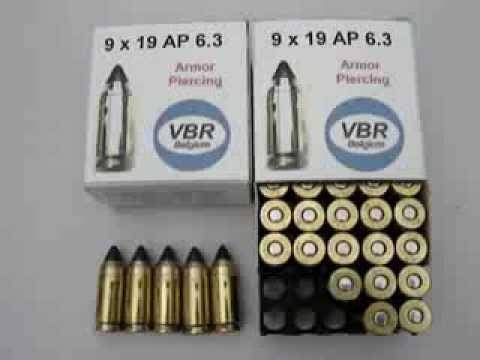
The idea itself is not new and was implemented on the basis of a wide variety of ammunition. It is worth noting that the case was not limited to one variant of bullets. It was possible to find references to the following types of cartridges. The cartridge with the designation 3P was equipped with three spherical lead projectiles. A cartridge with a low armor-piercing bullet was also offered, the designation is unknown for him, but it is known that he could pierce body armor of class IIA according to the NIJ classification. In addition to them, there is also a cartridge with the designation AP-HPF, this version of the ammunition is described as a cartridge with a bullet, the armor-piercing core of which is destroyed in the body of the enemy after the penetration of the bullet-proof vest. How this is achieved, unfortunately, is not entirely clear. For shooting in confined spaces, an ammunition version with a fully destructible bullet with the FRA designation was proposed. And of course there was a cartridge with an armor-piercing core with the designation AP.
For these munitions, kits were offered that made it possible to adapt the already existing models of weapons for new cartridges. It is interesting that, despite the same metric designation 7,92х24, there were two versions of the execution of ammunition. So the version of the “S” cartridges had a total length of 29,6 of a millimeter, which corresponds to that of the cartridge 9x19, respectively, the weapon for this cartridge could be adapted for 7,92x24S. The weapon version initially using the .45ACP cartridge was designated “N” and had a total length of a millimeter 32,4 cartridge. Such a breakup was achieved, apparently, by the depth of the bullet landing in the sleeve, the powder specimens were identical.
Despite the fact that the market was equipped with kits for adaptation to new ammunition, no exact data that matches at least two sources of information were found either by the weight of the bullets or by their initial speed. But it is known that for the version of the “S” cartridges the sets for the Glock and Browning Hi-Power pistols were released, but, apparently, “did not go”. But back to the gun machine gun MC-PDW.
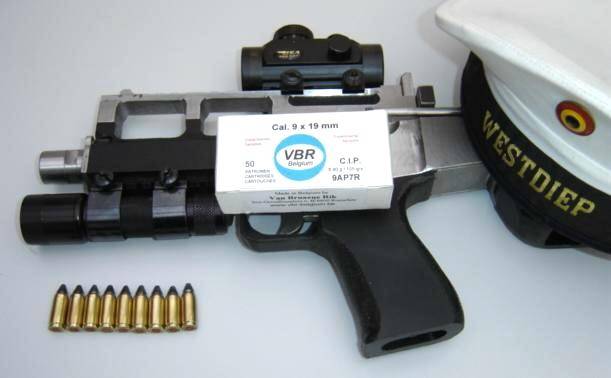
Already at first glance, it becomes clear to the weapon that it is not a serial sample, since it still has too many details that will later be “cut off”. Thus, a high stand for sighting devices, which would be appropriate in a full-fledged machine gun or light machine gun, but in no way the PP. Automatic weapons based on the principle of using the recoil energy in the short course of the trunk, with the locking barrel bore swinging larva. The analogy can be drawn with a Beretta 92F pistol. It feeds weapons from detachable shops of Glock pistols chambered for 9x19. The fire mode switch is located above the pistol grip; one of the positions also includes a weapon safety device. Trigger mechanism double action. An interesting feature of this submachine gun was the location of the handle of the bolt, which is similar to that of the AR15 and its like.
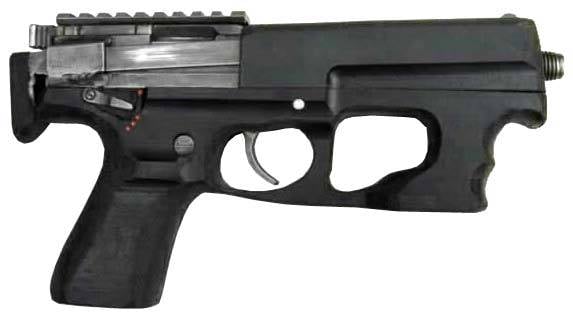
This weapon was created as a submachine gun, not inferior in terms of ease of carrying and using full-sized pistols, which, in this case, was clearly not achieved. Apparently, a high and definitely heavy stand for sighting devices was needed to balance the weapon and compensate for recoil with its weight when maintaining automatic fire. At the same time, it is obvious that the weapon does not have a convenient place to hold it with the second hand, which makes it difficult to conduct more or less aimed shooting at the line. In general, there were definitely flaws in the weapon, which were primarily related to ergonomics and wearing comfort.
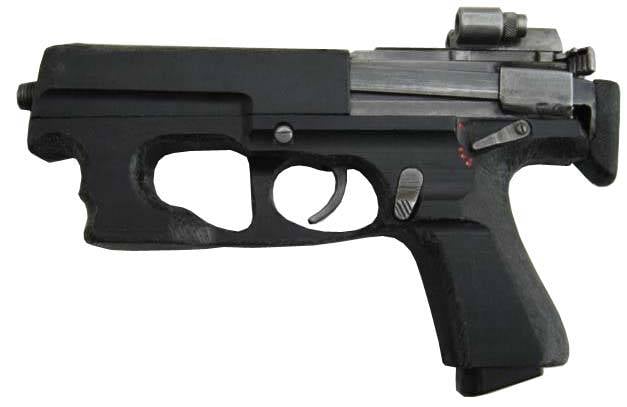
Of course, the developments were not simply thrown away, and the new pistol of a machine gun already under the designation PDW was soon demonstrated to the public. The updated version of the submachine gun already had a more thoughtful design. First of all, it should be noted that a place appeared under the PP barrel to securely hold the weapon with the second hand, which, together with the retractable butt, made the PDW submachine gun quite suitable for targeting automatic fire. From the high rack above the receiver refused, most likely because when you hold the weapon with both hands, it was simply not needed.
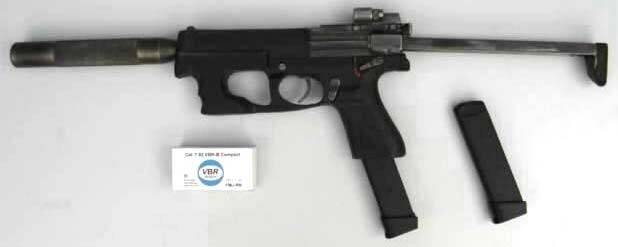
If we talk about the elements of control weapons, they are duplicated on both sides of the PP. The three-position translator of fire is located above the pistol grip and for most people it will be convenient to switch with the thumb of the holding hand. The store eject button is also two-sided, although its position and implementation raise questions. But unfortunately, the bolt latch has no weapon.
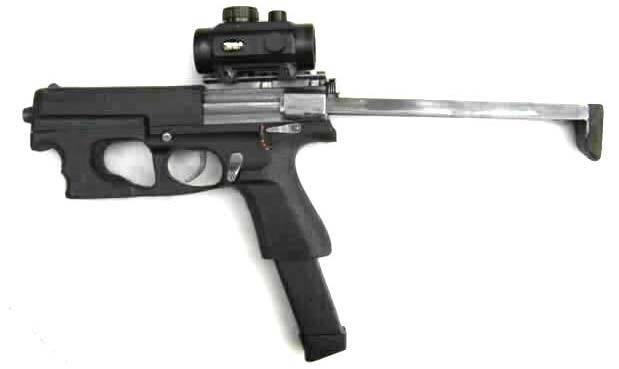
Of the interesting features of this submachine gun can be noted sights that allow you to aim with two eyes at once. Given the fact that such an aiming device is clearly too “original”, the designers have provided for its replacement with a collimator sight. It is also interesting that the barrel of the weapon is immediately equipped with a thread for installing a silent-firing device, which was offered with a weapon. True, it is not known whether cartridges with a subsonic bullet were developed for the full use of this option.
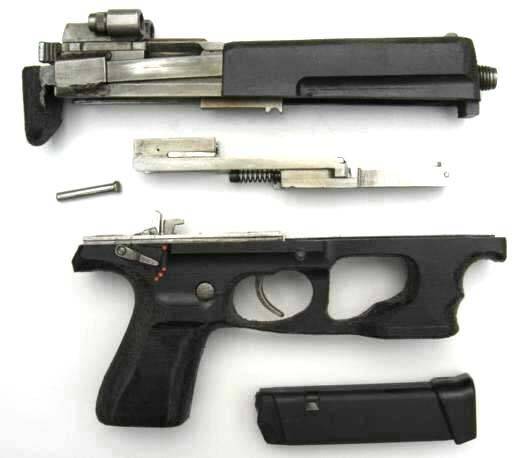
In numbers, this submachine gun is as follows. In the folded position, the total length of the weapon is 280 millimeters, with a barrel length 175 millimeters. The extended butt increases the overall length to 480 millimeters. The length of the proposed silent shooting device was equal to 183 millimeters. The thickness of the weapon is 43 millimeters, height 175 millimeters excluding the magazine. Weight without ammunition is 1,5 kilogram.
Based on all that has been written, we can say with confidence that the designers managed to come close to the goal. Of course, this submachine gun can not compete in weight and dimensions with pistols, however, it slightly exceeds these parameters in full-size models of pistols, made entirely of steel. Despite this, it must be remembered that polymers in handguns became widespread long before the start of designing this PP, and there were also enough submachine guns in this design. Well, if you add to all this new ammunition, it becomes clear why this PP did not receive distribution. However, the company had another project in stock, which even now, after almost 20 years, can be called very promising.
Submachine guns C-PDW, C-SMG, C22-1
A year earlier, before starting work on the submachine gun MC-PDW, the designers of the company developed another sample within the framework of the same idea of creating personal defense weapons for the military. This submachine gun was developed under the 9x19 and .45ACP cartridges and was significantly more interesting in terms of the set of solutions in its design.
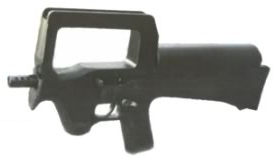 The basis of the new submachine gun was the bullpup layout, but its use was not dictated by the desire to reduce the overall length of the weapon while maintaining the maximum possible barrel length. It was used with only one purpose - to fill the unused space of the butt of the new PP. The second interesting solution was a screw shop that held up to hundreds of 9x19 cartridges. This shop was installed on top of the butt of the weapon, and played the role of a kind of emphasis under the cheek when aiming. The sights of the new submachine gun were dioptric, on a high stand for ease of aiming.
The basis of the new submachine gun was the bullpup layout, but its use was not dictated by the desire to reduce the overall length of the weapon while maintaining the maximum possible barrel length. It was used with only one purpose - to fill the unused space of the butt of the new PP. The second interesting solution was a screw shop that held up to hundreds of 9x19 cartridges. This shop was installed on top of the butt of the weapon, and played the role of a kind of emphasis under the cheek when aiming. The sights of the new submachine gun were dioptric, on a high stand for ease of aiming.With the beginning of the development of new ammunition, work on this PP was apparently suspended. After some time, the weapon changed its name to C-SMG, which can be explained by its transfer to the category of ordinary submachine guns. But soon, this sample again received the designation C-PDW after adaptation to the new cartridges and processing of the structure, which became modular. It should be noted that with the designation of individual samples of the company there was a complete mess, it was possible that those who worked on these weapons understood everything, and they saw a certain logic in this. In general, the latest version of this weapon is known as С22-1. It is with this model, as the most complete and try to get acquainted.
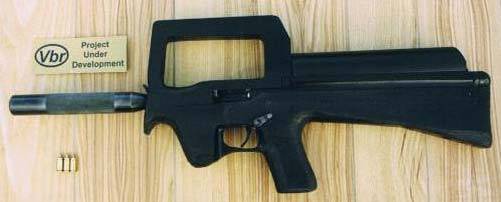
The weapon, like the original version of the submachine gun, has a bullpup layout and is powered from a screw shop. However, unlike the first option, this submachine gun consists of two parts: the top and bottom. At the bottom, only the trigger is mounted, at the top - everything else. There is a 3 variant of the bottom of the submachine gun. The first is a standard one, which does not give the PP any features that are not relevant to this class of weapon. The second more original, having a built-in rifle grenade launcher caliber 40 millimeters. Well, the most interesting option is the one that equips the weapon with a four-shot grenade launcher with a caliber of 22 millimeter shots. But let's deal first with the top of the weapon.
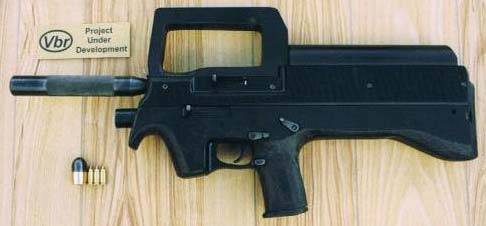
Automatics of the submachine gun is based on the principle of using the recoil energy in the free course of the shutter, there are no remarkable features to this weapon. From a screw shop cartridges are fed from the top, and thrown from the right side of the weapon. Sights, as well as in the first version of the PP, are located on a high rack. Under the rack to the right is the cocking handle, rigidly connected with the bolt group. Actually this is all that can be said about the top of the submachine gun.
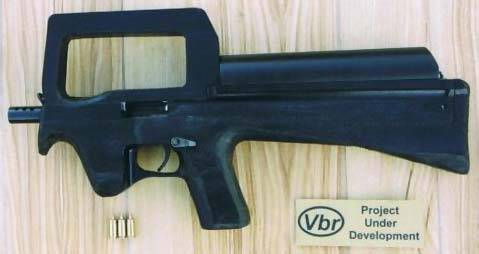
The lower part of the PP, depending on the version, has a different height, in its first version, without rifle-grenade launchers, it is simply a butt, a handle to hold and in fact is a body for the trigger mechanism of the weapon. On the right and left sides above the handle there is a translator of fire modes, also known as a fuse switch.
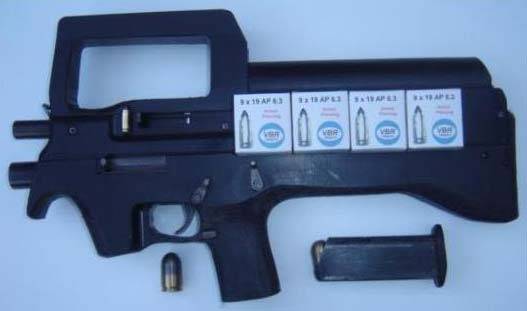
In the variant with a single-shot grenade launcher, both height and thickness increase significantly. The grenade launcher itself with manual reloading, similar in design to the M203. In order to shoot from it, the arrow must switch the switch located above the translator of fire.
But the most interesting option is the option of the lower part of the weapon, equipped with a self-loading grenade launcher for shots with a caliber 22 millimeter. It feeds this grenade launcher from a detachable magazine, which is inserted into the pistol grip to hold the PP and built on an automation system, which is based on the use of recoil energy in the short course of the barrel.
Despite the fact that the device is nominally a grenade launcher, its goals are somewhat different. Since the designers had the task to achieve maximum armor-piercing, which is difficult to do within the pistol cartridge, it was decided to develop such a grenade launcher. The shots of this grenade launcher can be both high-explosive, they were developed first, and in the form of an ordinary blank, which, if it does not penetrate the armored platinum, then upon contact guaranteed to break the ribs of the one on whom this armored platinum is fixed. By the way, according to the manufacturers, armor penetration of body armor of class IV protection was achieved. True or not, the solution is definitely interesting for the task.
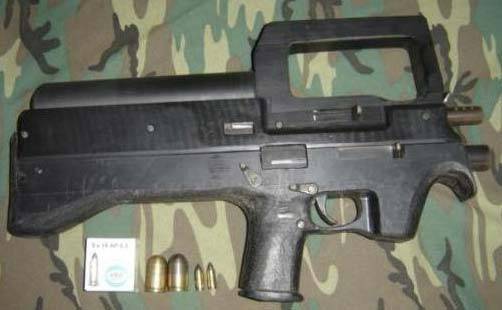
As it is not difficult to guess, these developments were not evaluated and the weapon did not spread. It didn’t help even the fact that the weapon itself was supplied in a wide variety of variants, both for new ammunition, and for the already familiar 9х19 and .45АСР. Considering the fact that the work on this submachine gun was constantly going on, it was not possible to find the exact numbers that characterize it, since everything depends on the version of the weapon, its barrel length and the ammunition that is used.
Сonclusion
Of course, it’s possible to call the weapons variants developed by VBR Belgium within the concept of personal defense weapons themselves promising and interesting. However, even when examining this weapon outwardly, it does not leave the feeling that the samples are clearly not refined and have a lot of flaws that are not found in more successful options from other companies. These disadvantages are related to ergonomics and the appearance of the weapon. Nevertheless, it should be noted that the individual solutions are very interesting, and in some cases even unique. In addition to the development of these machine pistols, there are still a lot of other very interesting projects in the company’s account, including machine guns for caseless ammunition, but this, as they say, is completely different story.
Judging by the website of the company VBR Belgium, at the moment, efforts are focused not on the development of firearms, but on the means of individual armor, among which it is possible to single out body armor for concealed carrying, as well as disguised as casual clothing. Apparently, if work on a new weapon is underway, then they are clearly not in priority, which is not surprising, considering how many failures there were. But to say that time and effort were wasted is still not worth it, since any experience in creating even if not the most successful sample can be taken over by other designers and individual solutions or ideas can become the basis for something new.
Sources:
dogswar.ru
raigap.dreamwidth.org
guns.wikia.com
eragun.org
knowledgr.com
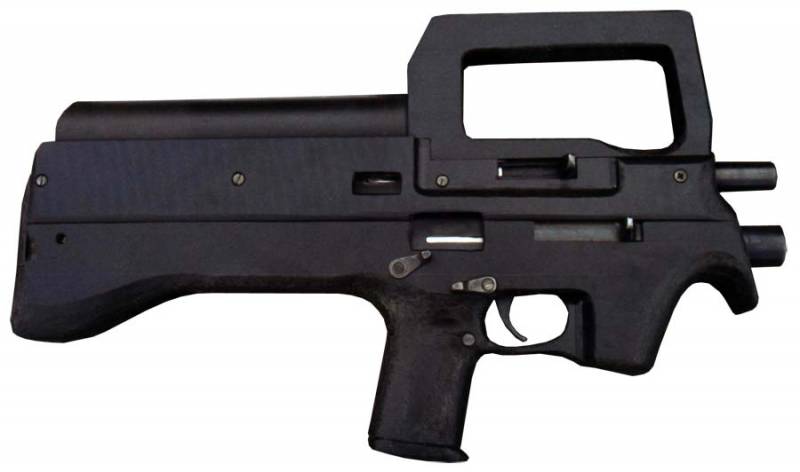
Information